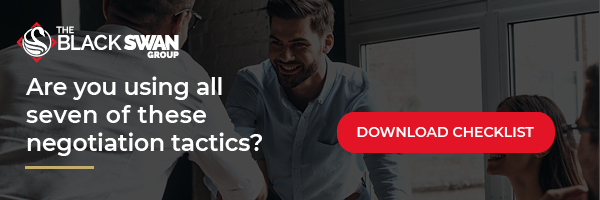The most dangerous negotiation is the one you don’t know you’re in.
Luckily, there’s an easy way to become aware of this: If the words I want or I need are about to come out of your mouth, then you’re about to enter into a negotiation.
Next time this is happening to you, try this little exercise that works like a charm every time. It’s easy peasy, and it’s great practice for the cold read and a quick accusations audit.

Finding Your Way Around
I ask people for directions all the time. I always have. Generally (as a side note), you may have to ask three different people to find out how to get somewhere (which, in the long run, is faster than wandering around). As soon as they say You can’t miss it, you know they left out an important detail.
The closest guy or gal at hand probably knows exactly what you’re looking for. More often than not, they just really don’t feel like telling you. You can almost hear what they’re thinking when you make your approach. They saw you wandering around a mile away, read your body language, and said to themselves, It’s not my job to tell some idiot how to find the event.
You can shatter that disposition by using a cold read and an accusations audit effectively. This will put the other side in a pleasant mood, and help you figure out how to get to where you’re going faster.
The Bozo Who Can’t Follow Directions
Here’s a real-world example of how these tactics work.
A while back, I was on my way to a LEAP Foundation mentoring event for youth at UCLA. LEAP is an awesome organization founded by Dr. Bill Dorfman).
It’s a Saturday, and the event is a pretty big one (thanks to Dr. Bill). LEAP does amazing work, and kids come from literally all around the world to attend these events because Dr. Bill gets celebrities like Mark Wahlberg and Paula Abdul to speak at them.
Although I was a little lost, I knew I was in the right parking ramp on the UCLA campus. But I also realized that if I went out the wrong way, I would have to travel all the way around the entire university complex to get to where I needed to be.
I started driving around inside the garage looking for a security guard or a maintenance person.
Because of the high-profile nature of the event, every employee had to have been aware it was going on. That, plus the fact that there’s probably no shortage of people like me looking for the entrance because we didn’t follow the directions closely enough. At this point, I assumed that most regular employees were probably hiding from the wandering “tourists” because they didn’t want to answer the same questions over and over again.
The phrase I don’t know was likely their ready response to any question that started with Can you help me.
Sure enough, as I passed by a number of parking spaces, I saw a maintenance guy at the far end of the garage, and I sped up to reach him.
“Hey man, I know it’s not your job to give directions to some bozo who’s lost and can’t find his way to where he’s going,” I said.
“Sure man,” the guy said, smiling. “No problem. What do you need?”
I told him and he happily gave me clear and concise directions.
Victory!
A Repeatable Approach in Any Scenario
I repeat that basic script all the time.
One of my favorite uses for it is to find a good restaurant at an airport. You know the TSA guys know which restaurant serves the best food. And you also know that they’re asked for their recommendations all the time.
Like most people, when the agents see someone approaching them, they think to themselves: It’s not my job to give directions. So, many times, instead of telling these travelers what their favorite restaurant is, they respond with I don’t know.
Here’s a tried-and-true method of getting these agents to help you figure out which restaurant is best.
I go up to TSA agents and say this: I’m sorry. Then I pause for one second and say I know it’s not your job to give recommendations.
Then I pause for a while—creating true dynamic silence. I wait for the agent to respond positively because I know they will.
This approach works every time, and you end up brightening their day.
People feel appreciated when you approach them this way. And as a general rule, people really want to help others. They just don’t want to be taken for granted in the process.
The cold read and the accusations audit are subcategories of tactical empathy.
In every negotiation, whether it’s low stakes or high stakes, we use empathy because it works. Quickly. And it makes people feel better.
Put yourself in the other side’s shoes. They’ll notice, and they’ll reward you for it.
Make it rain!

